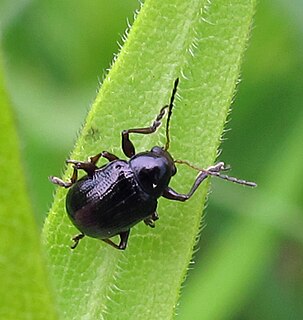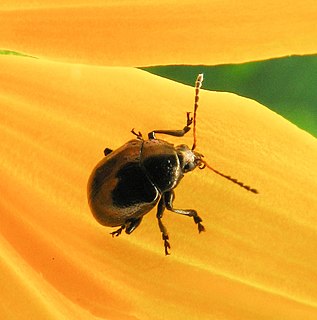
Paria thoracica is a species of leaf beetle. It is found in North America.

Paria is a genus of leaf beetles in the subfamily Eumolpinae. There are about 40 described species in Paria in North and South America, 19 of which are known north of Mexico. The genus is very similar to Typophorus.
Metachroma suturale is a species of leaf beetle. It is found in the United States, ranging from Arizona to Texas. Its length is between 4.8 and 6.4 mm.
Paria opacicollis, the oak parium, is a species of leaf beetle. It is found in North America.
Metachroma angustulum is a species of leaf beetle. It is found in the United States.
Tymnes oregonensis is a species of leaf beetle. It is found in North America.
Tymnes metasternalis is a species of leaf beetle. It is found in North America.
Colaspis costipennis is a species of leaf beetle from North America. It is mostly found in coastal states; in the United States, its range extends from Louisiana and Georgia north to New Hampshire and Pennsylvania, and in Canada, it is reported from Ontario. It was originally described as a variety of Colaspis brunnea, but it is now recognised as a distinct species.
Promecosoma arizonae is a species of leaf beetle. It is found in southern Arizona and in New Mexico in the United States, as well as in Mexico.
Graphops pubescens is a species of leaf beetle. It is found in North America.
Glyptoscelis alternata is a species of leaf beetle. It is found in North America.
Metaparia clytroides is a species of leaf beetle. It is found in North America.

Brachypnoea puncticollis, the rose leaf beetle, is a species of leaf beetle. It is found in North America.
Colaspis nigrocyanea is a species of leaf beetle from North America. It is distributed in Arizona and Mexico. It was first described by the British entomologist George Robert Crotch in 1873.
Xanthonia villosula is a species of leaf beetle. It is found in the eastern United States and eastern Canada. It is associated with numerous woody plants including oaks.
Metachroma floridanum is a species of leaf beetle. Its distribution ranges from Florida to North Carolina in the United States.
Metachroma luridum, the dark-sided metachroma, is a species of leaf beetle. It is found in Central America and North America. Its length is between 3.5 and 4.0 mm.
Paria quadriguttata, the willow parium, is a species of leaf beetle. It is found in Central America and North America.
Glyptoscelis illustris is a species of leaf beetle. It is found in North America.
Dubiraphia quadrinotata is a species of riffle beetle in the family Elmidae. It is found in North America.


